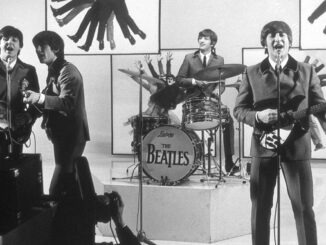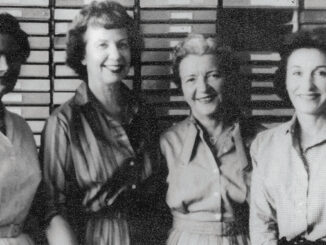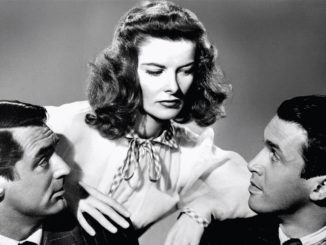
by Holly Sklar
“Excellent melodrama. Colorful, timely background, tense mood, suspense, psychological and physical conflict, tight plotting, sophisticated hokum. A box office natural.”
– Stephen Karnot, Warner Bros. story analyst, in his coverage of an unproduced play, “Everybody Comes To Rick’s,” the basis of “Casablanca.”
If you’ve worked on a Hollywood-produced movie as a Motion Picture Editors Guild member, chances are a Local 700 story analyst “covered” it first. Long before the cameras rolled, the footage came to post, and the movie made its way to audiences, a story analyst like Stephen Karnot wrote coverage on it: a summary of the nascent material’s story, and an evaluation of its big-screen potential.
Story analysts have long played an essential, yet unheralded, part in Hollywood’s movie-making machinery. They date back to the industry’s beginning and continue to play a critical role in helping to choose which movies are made, refining screenplays as they move through the development process toward a green light. Yet their history is little known inside, let alone outside, the industry.
Even less has been shared about the vital role they played in Hollywood’s early labor movement. Story analysts organized and fought battles from which today’s union story analysts, as well as members of all Hollywood IA locals, still reap benefits.
Both these threads — their fundamental role in the movie business and the fight for what Hollywood unions established and work to maintain — are interwoven in a compelling, behind-the-scenes tale that continues to unfold.
It was December 9, 1941, two days after the attack on Pearl Harbor, when 35 year-old story analyst Stephen Karnot covered Murray Burnett & Joan Alison’s “Everybody Comes To Rick’s.” Karnot, who was making $1.12 per hour, identified it as an ideal vehicle for Humphrey Bogart. It was Karnot’s boss, Warner Bros. story department head Irene Lee, who convinced producer Hal Wallis to buy it and assign screenwriters Julius & Philip Epstein and Howard Koch to turn it into a screenplay. But no doubt Karnot’s savvy coverage helped shepherd it on its journey. He knew that when it comes to good storytelling, “the fundamental things apply,” as the song from “Casablanca” goes. (The tune is still played before present-day releases when the Warner Bros. shield appears on screen.)
Today, as in 1941, raw material comes to producers and studio executives in many forms: screenplays, plays, novels, graphic novels, short stories, comic books, non-fiction books, magazine or newspaper articles, or a foreign fillm with English-language remake potential. It’s a story analyst’s job to filter the wheat from the chaff. And in the modern era, story analysts are far more than filters. They routinely write the development notes (aka comparison coverage) on drafts of screenplays in development, notes busy producers and executives rely on to help screenwriters shape the material before it gets on screen.
Yet despite doing this vital work, story analysts are practically invisible even to the higher-ups who count on them. In George S. Kaufman & Moss Hart’s hit 1930 Broadway satire of Hollywood, “Once in a Lifetime,” voluble studio head Herman Glogauer shows up to a movie set on the last day of shooting, only to realize the director has shot the wrong script. Glogauer proclaims, “After this, I make a ruling – every scenario we produce, somebody has got to read it.” In fact, “somebody” – story analysts — had been reading those “scenarios” as early as the 1910s. (For an example of one of those early story analysts, see the CineMontage story on MGM’s Kate Corbaley.)
From the teens through the 1950s, when Americans were movie-mad and often attended several pictures a week, the studios churned out around 400 movies annually to meet demand. At MGM alone, the analysts of the story department handled more than 20,000 pieces of material a year. Nearly all the major studios maintained story departments on both coasts. They employed both “inside” (in-house, union) analysts paid by the hour, as well as “outside,” work-at-home analysts paid by the piece of material, with differing rates for screenplays and books, etc.
Early story analysts realized that organizing into a union was key to a decent living in the business. Writers, actors, directors and below-the-line workers had similar ideas. Thankfully, some writers who’d come from story analyst ranks were sympathetic to the cause.
In 1934, former Universal story analyst Don Gordon attended a meeting of the Screenwriters Guild (later the WGA), where he rose to decry “sweatshop conditions” under which story analysts labored, an incident that made it into The Hollywood Reporter. Dalton Trumbo (“Roman Holiday,” “Spartacus,” “Exodus”), who had started as an analyst and by 1939, was making his living as a screenwriter, hosted the very first meeting of what would become the Screen Story Analyst Guild at his home on Hollyridge Drive. Mystery novelist/ screenwriter Dashiell Hammett (“The Maltese Falcon,” “The Thin Man”) was the guest speaker, and likely his longtime girlfriend, story analyst turned playwright/screenwriter Lillian Hellman (“The Children’s Hour,” “The Little Foxes”) was also in attendance.
In 1939, the National Labor Relations Board recognized the new Guild as the bargaining agent for all story analysts, then called “screen readers,” at the major studios. The Guild demanded a wage hike, shorter hours, and improved working conditions, all of which it soon gained for its members: a 40-hour week, with straight time up to 44 hours and time and a half after that; a rate of $45 dollars per week, with a “Special Read- ers” rate of $55 (perhaps for the more creative work, e.g., listening to pitches and turning them into treatments/ synopses). Apprentices started at $30 weekly, with wages set to increase as they accumulated experience, an early version of a provision still seen in the current contract, which raises the pay scale per months on the job, up to 55 months. In those days, the Guild was the bargaining agent for both in-house and the aforementioned “outside” analysts.
The Feminine Mystique
Studio story departments provided a rare bright spot for working women, particularly educated women who didn’t have so many avenues open to them in the working world. Some rose to eventually run these departments after being promoted from the ranks of readers, holding then rare-for-women executive jobs. One such woman was Columbia journalism school drop-out Frederica Sagor Maas, who served as a script reader at Universal’s east coast story department and was upped to story editor in the 1920s before ultimately pursuing screenwriting. Novelist Winnifred Eaton took a similar path, briefly running Universal’s East Coast, and then its West Coast, story departments, before moving on to screenwriting. (Eaton’s granddaughter is now-retired, longtime Warner Bros. story analyst Diana Birchall, whose father and son also worked as analysts; Birchall believes hers is the only family that can count four generations in the profession).
But this tale of women-dominated story departments in old Hollywood isn’t as empowering as it looks. Male studio executives of the time may have had the notion that women were best-suited to judge material that would draw female moviegoers. Naturally, there were male readers on staff too: director/producer Mervyn Leroy claimed, “as a rule, a man is better qualified” to read “highly technical books on aviation, or on naval maneuvers” – e.g., source material for war movies. Such bias has been around as long as Hollywood. It’s possible story analysts’ status in the studio hierarchy – low despite the vital part they played in the studio’s movie-making machinery – might have something to do with the female-heavy departments in which the work was originally done.
Male and female story analysts took an outsized, highly visible part on the front lines of strikes in the mid-1940s. In the Hollywood Quarterly, Paramount story analyst Frances Kroll Ring recalled that in a 1945 strike involving 6,000 motion picture workers, “the paradox of (the story analysts’) numerical size and their prominence in the strike caused a producer’s representative to comment, with mingled admiration and annoyance, ‘Who would have thought those cream puffs could raise so much hell?’”
During the 1946-47 Conference of Studio Unions (CSU) strike, story analysts voted to honor the picket lines on behalf of striking painters and set decorators. Analysts were hurt in tussles outside of Warner Bros. and Technicolor. A woman analyst even filed suit against four men for $50,000 in damages for assault and battery after being knocked unconscious. Eventually, the IA supplanted the CSU as Hollywood’s below-the-line union and the story analysts’ original guild evolved into IA Local 854. (The story analysts became part of Local 700 in 2000.)
In the Depression and World War II years, some analysts were among the labor movement activists who fell under the spell of Communism. John Weber, a Paramount story analyst who’d actually come to town as a Communist trying to infiltrate Hollywood, briefly served as the Guild’s president before being promoted to assistant story editor; he eventually went to work at the William Morris Agency.
But most analysts were just trying to improve wages and working conditions, like onetime union VP and subsequent screenwriter/novelist/TV show creator Sidney Sheldon (“I Dream Of Jeannie,” “Hart To Hart”). During World War II, patriotic union analysts volunteered their services recommending books and other material to be distributed abroad by the Office of War Information, in hopes of fostering sympathy for the Allied cause.
In the McCarthy era, a few analysts were alleged to be Communists in a letter written by California Congressman and future Los Angeles mayor Norris Poulson to Parnell Thomas, then chair of the House Un-American Activities Committee (HUAC). Among these were former presidents of the Guild, Warner Bros. analyst Matty Mattison and Paramount story analyst Frances Millington. Ironically, Thomas was indicted for corruption and served time at the same prison where screenwriters Ring Lardner, Jr. and former story analyst Lester Cole were serving time after HUAC charged them with contempt.
The committee also heard from “friendly” witnesses: novelist/firebrand of the right Ayn Rand, who had relied on her story analyst pay until making it as a writer, and novelist/screenwriter Budd Schulberg, who worked in David O. Selznick’s story department early on. Some never forgave Schulberg for naming names in front of HUAC. He left a complex legacy, highlighting the plight of the working man in “On The Waterfront,” skewering Hollywood opportunism in his novel “What Makes Sammy Run,” and depicting the rise of a power-hungry populist TV guru in his uncomfortably prescient screenplay, “A Face In The Crowd.”
In the golden age of Hollywood, union story analysts numbered a little more then 100. The union fell to its working membership nadir – about 65 members — in the early 1970s, around the same time the number of movies released annually hit historic lows. Happily, the studios clung to life and later returned to robust, if modified, form as components of media conglomerates. There have been bumps in the story analysts’ road — the New York story departments were replaced by book scouts, and the 1988 WGA strike saw many of us laid off — but the numbers rebounded to approximately 90 union analysts today.
The major studios, plus a few larger production companies, still employ union story analysts. Production companies that are not signatory, as well as talent agencies, typically hire non-union freelancers. Of the latter, there’s high turnover and attrition due to the difficulty of making a living without the benefit of the union’s mandated hourly wages plus pension and health benefits. Union analysts stay on the job with a single employer for years, sometimes decades. They’re valued for their breadth of experience and institutional knowledge, and are often assigned projects based on their strengths in certain genres. They’re also relied on for their experience in handling arcane aspects of the job, e.g., writing comparisons of intellectual property and writing credit determinations for studios’ legal departments.
Among Local 700 analysts are some with undergraduate and graduate degrees from leading film schools. They are serious movie buffs with a genuine love of the form, looking for the best amidst the raw material they are given and nudging/nurturing it along. They write their commentary in a sincere attempt to make each and every screenplay realize its potential for studio employers.
The union story analysts of Local 700 enjoy the wages, benefits, and working conditions for which those early story analysts and other Hollywood workers fought. Story analysts in the 1930s-40s were unwilling to settle for “sweatshop conditions” and in strikes and contract negotiations, demanded and often earned better wages and working conditions, something that redounds to the benefit of all IA member currently working. Present at the creation of Hollywood, story analysts remain essential to the movie-making apparatus. They have been there when it counted in Hollywood workers’ fight for good hourly wages, better working conditions and increased employer pension and healthcare contributions.
While the movie business is evolving, content – which is, at its heart, good storytelling – remains king. Story analysts continue to mine stories from mountains of submitted material and help producers, executives, and writers shape those stories into screenplays that become box office gold. That gold will help IA members earning a real living – and health and pension benefits – while we all go about the business of entertaining the world. ■
Holly Sklar is a veteran story analyst and member of the Guild’s Board of Directors.





